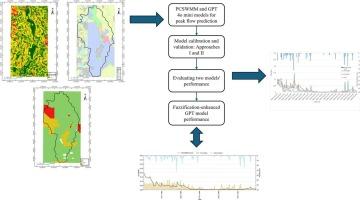基于模糊输入的不确定性量化方法在确定性模型中与ChatGPT进行峰值流量预测的比较
IF 3.1
Q2 GEOSCIENCES, MULTIDISCIPLINARY
引用次数: 0
摘要
ChatGPT是一种生成式人工智能,用于模拟4 - 9月径流期小流域的峰值流量,并与PCSWMM水文模型进行了比较。提出了一种降雨和峰流误差的模糊数学表示方法,得到了基于模糊的GPT模型和基于模糊的PCSWMM模型。这导致两种模型的输出都是模糊的,并且在数据错误和大型语言模型结构的情况下,两种模型的应用都更合适。训练和验证以大约25/75的数据分割进行,再次使用75/25的数据分割。评估指标用于比较不同数据分割场景下的模型性能。经过校准和验证的PCSWMM在25/75数据分割中优于GPT,但ChatGPT 40 mini一代在75/25数据分割中优于PCSWMM,并且具有可比的验证指标,并且应用程序比使用PCSWMM时更轻松。基于模糊的误差分析表明,对于两个模型,基于模糊的方法产生的结果比原始模型更具有可解释性和合理性。此外,GPT - 40迷你模型在高隶属度水平(∝-cut)下的模糊输出的覆盖范围(不确定范围)和精度之间的权衡表明,在数据稀缺条件下,预测性能得到增强。本文章由计算机程序翻译,如有差异,请以英文原文为准。

Fuzzy-based input method for uncertainty quantification in a deterministic model comparison with ChatGPT for peak flow prediction
ChatGPT, a generative AI, is applied and compared to the PCSWMM hydrological model for modelling peak flow in a small watershed in the runoff period of April to September. A new approach for fuzzy mathematical representation of rainfall and peak-flow errors was developed to lead to a fuzzy based GPT model and fuzzy based PCSWMM model. This led to fuzzy output for both models and a more appropriate application of both models given data errors and large language model structure. Training and validation were conducted with an approximately 25/75 split of the data and again using a 75/25 data split. Evaluation metrics were used to compare model performance under the different data-split scenarios. Calibrated and validated PCSWMM outperformed GPT in the 25/75 data split but ChatGPT 4o mini’s generation outperformed PCSWMM in the 75/25 split and with comparable validation metrics and an application that was less onerous than when using PCSWMM. The fuzzy-based error analysis showed that for both models, a fuzzy-based approach produced more interpretable and reasonable results than either original model. Moreover, the trade-off between coverage (uncertainty range) and precision for GPT‑4o mini model’s fuzzy output at high membership levels (∝-cut) demonstrated enhanced predictive performance under data‑scarce conditions.
求助全文
通过发布文献求助,成功后即可免费获取论文全文。
去求助
来源期刊

Journal of Hydrology X
Environmental Science-Water Science and Technology
CiteScore
7.00
自引率
2.50%
发文量
20
审稿时长
25 weeks
 求助内容:
求助内容: 应助结果提醒方式:
应助结果提醒方式:


